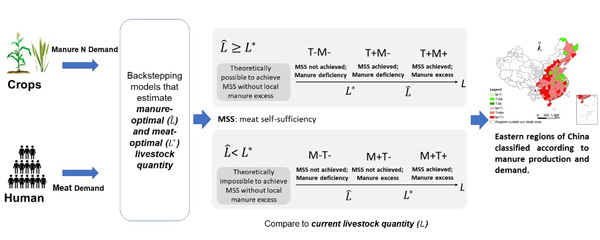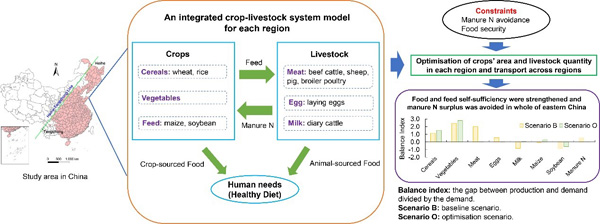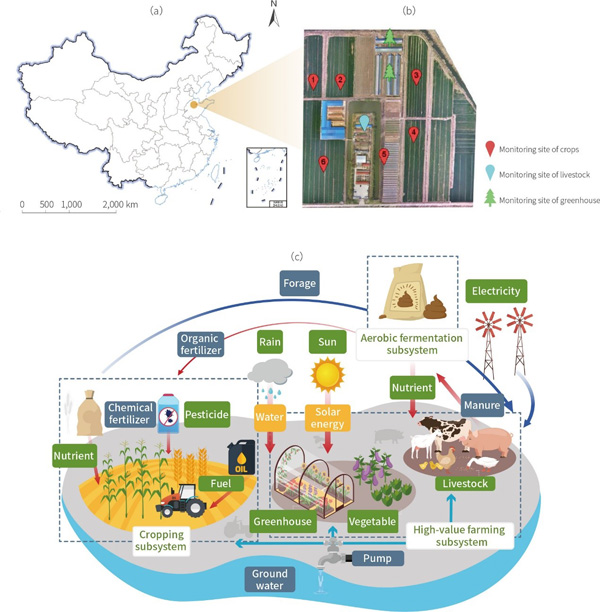Researchers Reveal the Spatiotemporal Patterns and Optimization Solutions of Regional Crop-livestock Structure
Crops and livestock are two important parts of the agricultural industry. The unreasonable crop-livestock structure is a severe challenge for regional food security and the ecological environment.
Prof. SUN Zhigang's team at the Institute of Geographic Sciences and Natural Resources Research, Chinese Academy of Sciences collaborated with scholars from the France National Research Institute for Agriculture, Food and Environment (INRAE) to make progress in the regional crop-livestock structure diagnosis and optimization.
The researchers built a crop-livestock structure thematic dataset at the Chinese prefecture level, developed the theory of comparative advantage, and proposed regional balance indices of production and demand for food, feed, and livestock manure N.
Based on the crop-livestock structure thematic dataset at the Chinese prefecture level, they conducted diagnostic analyses on the spatial and temporal patterns, as well as potential issues, of regional crop-livestock production structures, crop-livestock product supply and demand structures, and the balance of production and demand for livestock manure N in China. They found the crop-livestock production structure in eastern China was not coordinated through quantitative analysis.
To balance the regional crop-livestock production structure, they presented a spatial optimization model for crop-livestock structure considering coordination among regions, resource complementarity, and transportation routes and costs. Utilizing this model, they conducted optimization scenarios analyses and solutions on the crop-livestock structure of eastern China. Most of the food and feed items except soybean were self-sufficient and manure N surplus was avoided after optimization. As soybean subsidies increased from 0 Yuan ton-1 to 6000 Yuan ? ton-1, the self-sufficiency of soybeans increased by 66.37%.
In addition, they carried out a case study on a typical integrated crop-livestock farming system in the low-medium-yield region along the lower reaches of the Yellow River. The practice demonstrated that integrated crop-livestock farming systems exhibit higher economic benefits and lower environmental loading, thereby enhancing the resilience and sustainability of the food production system.
The team in above study hoped to improve the theory and methodology on the diagnosis, analysis, and optimization of regional agricultural production layout.
The above researches were supported by several funding projects, including the Strategic Priority Research Program of the Chinese Academy of Sciences, the Science Fund for Creative Research Groups of the National Natural Science Foundation of China, and the Youth Project of Natural Science Foundation of Shandong Province. The related results were published in 7 papers and 1 research report.

Figure 1. Spatial distribution of food and feed balance indices in eastern regions of China in 2017. (Image by Prof. SUN’s team)

Figure 2. The roadmap of analyzing the trade-off between meat self-sufficiency and manure N surplus avoidance. (Image by Prof. SUN’s team)

Figure 3. The optimization model framework describing the relationship among crops, livestock, human compartments in each region, as well as the relationship among regions (including the outside of the study area). (Image by Prof. SUN’s team)

Figure 4. The location, layout, and structure of the integrated crop-livestock farming system in the low-medium-yield region along the lower reaches of the Yellow River. (Image by Prof. SUN’s team)
Reference:
Li, Y., Shi, Y., Deng, X., Sun, Z., Accatino, F. (2024). Increasing food and feed self-sufficiency and avoiding manure N surplus in eastern regions of China through a spatial crop-livestock optimisation model. Agricultural Systems, 217, 103911. https://doi.org/10.1016/j.agsy.2024.103911.
Li, Y., Sun, Z., Deng, X., Accatino, F. (2024). Reducing livestock quantities to avoid manure nitrogen surplus: Would meat self-sufficiency be met in eastern regions of China? Resources, Environment and Sustainability, 100156. https://doi.org/10.1016/j.resenv.2024.100156.
Li, Y., Sun, Z., Accatino, F. (2022). Satisfying meat demand while avoiding excess manure: Studying the trade-off in eastern regions of China with a nitrogen approach. Science of The Total Environment, 816, 151568. https://doi.org/10.1016/j.scitotenv.2021.151568.
Li, Y., Sun, Z., Accatino, F. (2021). Spatial distribution and driving factors determining local food and feed self‐sufficiency in the eastern regions of China. Food and Energy Security, 10(3), e296. https://doi.org/10.1002/fes3.296.
Li, Y., Sun, Z., Accatino, F., Hang, S., Lv, Y., Ouyang, Z. (2021). Comparing specialised crop and integrated crop-livestock systems in China with a multi-criteria approach using the emergy method. Journal of Cleaner Production, 314, 127974. https://doi.org/10.1016/j.jclepro.2021.127974.
Li, Y., Sun, Z., Liu, E., Shao, C. (2021) Spatio-temporal evolution of regional structure about crops and livestock in China based on the theory of comparative advantage. Journal of natural resources, 36(5): 1149-1162 https://doi.org/10.31497/zrzyxb.20210505 (in Chinese).
Li, Y., Sun, Z., Zhang, X., Yang, J., Hang, S., Li, S., Zhu, W., Lyu, Y., Ouyang, Z. (2019) Spatial pattern and evolutionary trend of sustainable development index of crop-livestock system: A case study in Shandong Province, China. Chinese journal of applied ecology, 30(07), 2371-2383 https://doi.org/10.13287/j.1001-9332.201907.020 (in Chinese).
Download attachments: